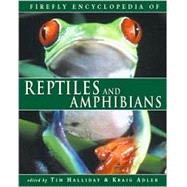
Tim Halliday is Professor of Biology at the Open University, England, where he teaches animal behavior and evolutionary biology, and researches the mating dynamics of newts, frogs and toads. He has written or edited several books and numerous scientific papers about amphibian sexual behavior. In the last ten years, he has concentrated on global declines among amphibian populations. He is the International Director of the IUCN/SSC Declining Amphibian Populations Task Force.
Dr. Kraig Adler is Professor of Biology at Cornell University. His research includes animal orientation and navigation, and the systematics, ecology and evolution of amphibians and reptiles which he has studied in the field around the world. Dr. Adler's research is widely published and he has written or edited eight books, including co-authoring Herpetology of China (1993) and Captive Management and Conservation of Amphibians and Reptiles (1994). He served as President of the Society for the Study of Amphibians and Reptiles and was elected the first Secretary-General of the World Congress of Herpetology.
| Preface | p. 8 |
| Amphibians | p. 10 |
| Classification and Taxonomy | p. 20 |
| A Key Amphibian Event | p. 22 |
| Kaleidoscopic Adaptation | p. 24 |
| Conscientious Parents | p. 26 |
| Amphibian Population Decline | p. 30 |
| Amphibian Conservation | p. 34 |
| Swimming, Eating, Growing Machines | p. 36 |
| Caecilians | p. 38 |
| Salamanders and Newts | p. 42 |
| Salamander and Newt Families | p. 56 |
| Courtship and Mating in Salamanders and Newts | p. 60 |
| Repellent Defenders | p. 62 |
| Frogs and Toads | p. 64 |
| Frog and Toad Families | p. 82 |
| Leaps and Bounds | p. 88 |
| Decoding the Frog Chorus | p. 92 |
| From Tadpole to Frog | p. 96 |
| Reptiles | p. 98 |
| The Age of Reptiles | p. 106 |
| Temperature Control in Reptiles | p. 108 |
| Reptiles at Risk | p. 110 |
| Play in Reptiles | p. 112 |
| Pre-ejaculators, Sneakers, and She-males | p. 114 |
| Temperature and Sex | p. 116 |
| Turtles and Tortoises | p. 118 |
| Turtle and Tortoise Families | p. 130 |
| The Asian Turtle Crisis | p. 134 |
| Leatherbacks: Birth on the Beach | p. 136 |
| Lizards | p. 138 |
| Natural Desert Dwellers | p. 148 |
| Lizard Families | p. 170 |
| Worm-lizards | p. 176 |
| Snakes | p. 178 |
| Venomous Snakes | p. 188 |
| The Threat from Snakebites | p. 202 |
| Snake Families | p. 204 |
| Harvesting Snake Venom | p. 208 |
| Tuatara | p. 210 |
| Crocodilians | p. 212 |
| Pollution and Hormone Mimics | p. 222 |
| Unisexuality: The Redundant Male? | p. 224 |
| Glossary | p. 226 |
| Bibliography | p. 228 |
| Index | p. 232 |
| Picture and artwork credits | p. 240 |
| Table of Contents provided by Syndetics. All Rights Reserved. |
The New copy of this book will include any supplemental materials advertised. Please check the title of the book to determine if it should include any access cards, study guides, lab manuals, CDs, etc.
The Used, Rental and eBook copies of this book are not guaranteed to include any supplemental materials. Typically, only the book itself is included. This is true even if the title states it includes any access cards, study guides, lab manuals, CDs, etc.